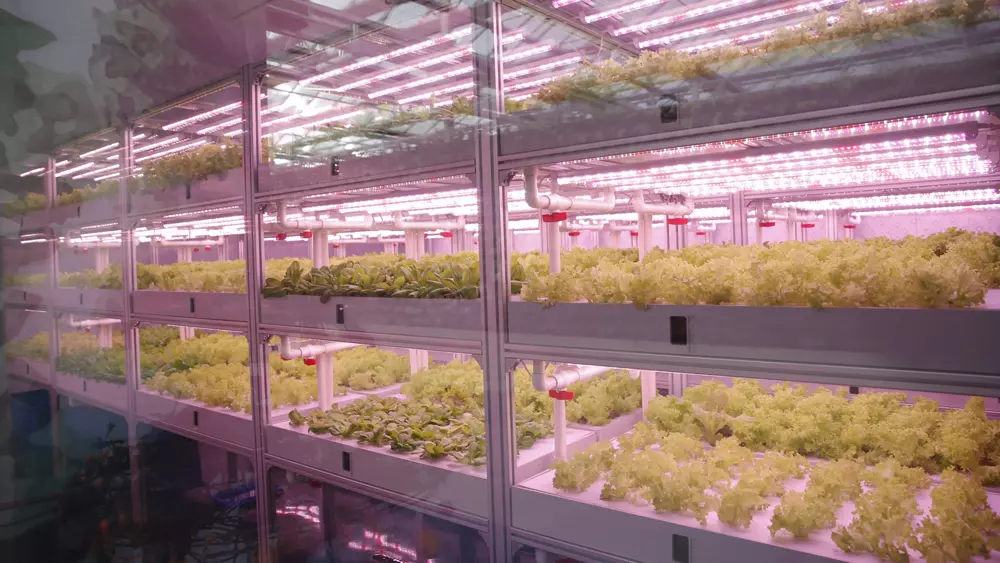
The development of artificial light plant cultivation is closely related to the innovation of electric light sources and the process of human understanding of plant photobiology. Since the 1980s, the rapid development of LED semiconductor light source technology has provided tools for the study of light quality biology, and promoted the process of ED as an artificial light source for plant cultivation. At present, as the highest form of facility horticulture, LED light source plant factories that implement high-precision environmental intelligent control based on the characteristics of plant biological needs are developing rapidly.
The production and operation of an intelligent plant factory not only requires the automation of environmental factor control, water and fertilizer supply and allocation control, but also requires automatic operation in the production links such as seedling raising, transplanting, and harvesting, so as to reduce the interference and pollution of the production space caused by human activities. The intelligent management and control of plant factory operation and production all consume electricity. The energy consumption of artificial light plant factory includes light source, air conditioner, pumping system, pneumatic system, detection and control system, etc.
As far as artificial light plant factories are concerned, the lighting system has the largest energy consumption, accounting for more than 60% of the total energy consumption; followed by the air conditioning system, accounting for more than 30%, and the remaining management and control systems consume relatively little energy. At present, the cost of operating energy consumption has become the main component of the operating cost of the plant factory, which is an important reason for the high operating cost of the plant factory. Therefore, reducing the energy consumption of the lighting system has become the main way to save energy and increase efficiency in plant factories.
The core of plant factory production is that plants grow rapidly according to people’s food needs and obtain high-quality agricultural products. Therefore, all environmental factors, nutritional factors and management factors related to plant health and production efficiency need to be controlled. As the only source of environmental signals and energy for photosynthesis, light is an essential environmental factor for the growth and development of facility plants and the formation of yield and quality.
In nature, sunlight varies with geographic latitude, seasons and weather conditions. High latitudes and most other regions are affected by cloudy days, rain, snow, fog and haze, as well as air pollution and floating dust in winter and spring. Insufficient light time, insufficient light intensity and lack of light quality are serious, which seriously affect the growth and development and high-quality and efficient production of crops, especially horticultural crops.
At the same time, the lack of light time in high latitude areas and the weak light and little light caused by rainy weather in low latitude areas make the light environment (light intensity, light quality and photoperiod) in facilities such as solar greenhouses and plastic greenhouses unable to meet the growth and development of facility crops. The demand for yield quality has limited the production potential of facility horticulture. In addition, the scale of artificial light cultivation has increased significantly. Obviously, suitable artificial light environment regulation plays an indispensable role in the high-quality, high-yield, ecological and safe production of facility horticulture.
Only by setting up artificial light environment and management strategies according to the photobiological needs of facility plants, and carrying out dynamic and intelligent management, can facility gardening completely get rid of the constraints of natural conditions and realize artificial control. At the same time, the spectral energy distribution of traditional artificial light sources is fixed and cannot be controlled, only the light intensity and photoperiod can be controlled. The proportion of photosynthetically active radiation is small, the amount of invalid thermal radiation is large, the light efficiency is low, and energy consumption is high, resulting in high energy consumption in facility horticultural production. No, it needs to be solved urgently.
The demand for artificial lighting in facility agricultural production is increasing year by year, and artificial light supplementation and precise control of the light environment have become important technologies that determine the output quality and production efficiency of facility agriculture. For a long time, due to the poor overall environmental control performance of facility horticulture, light environment regulation is also a production shortcoming. In addition, the laws of plant photobiology, especially the biology of plant light quality, are not clear, and energy-saving and efficient light environment regulation strategies cannot be formulated, which also hinders the development of agricultural lighting. Finally, the controllability of traditional electric light sources is poor, and it is impossible to adjust the light quality, light intensity and photoperiod according to the needs of plants, and it is difficult to meet the practice of agricultural lighting and the environmental protection concept of on-demand lighting. Agricultural lighting has the characteristics of many fields, complex biological principles and control indicators, strong professional lighting, and precise control system.
With the development of high-precision environment-controlled facility horticultural plant factories, as well as the technological maturity and progress of semiconductor light source LEDs, artificial light environment regulation has gradually moved into practice. Segment management and intelligent management and control maximize the biological benefits of light environment regulation, and provide a new and effective means for coping with low-light and low-light stress, regulating plant growth and development and the formation of yield and quality.
